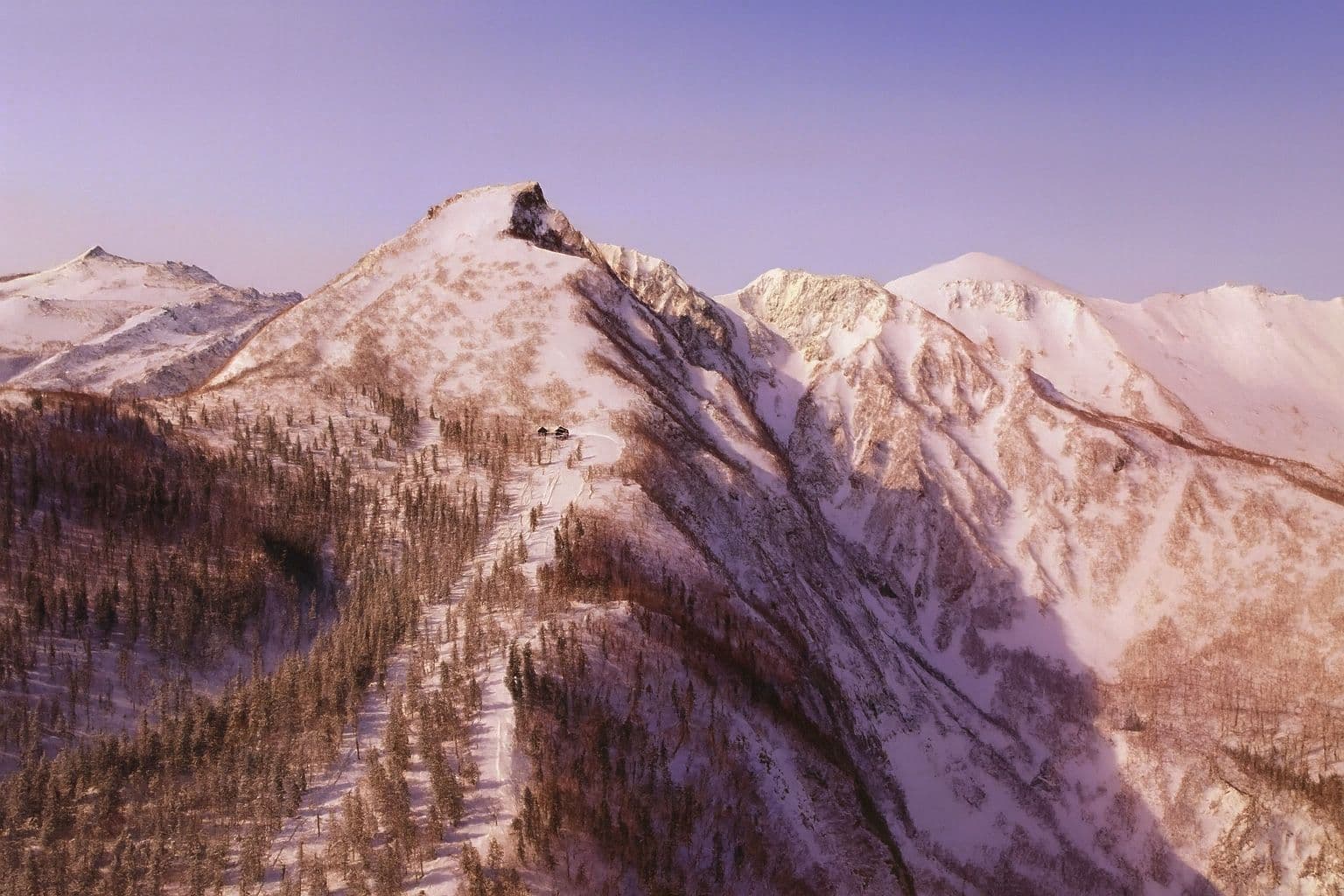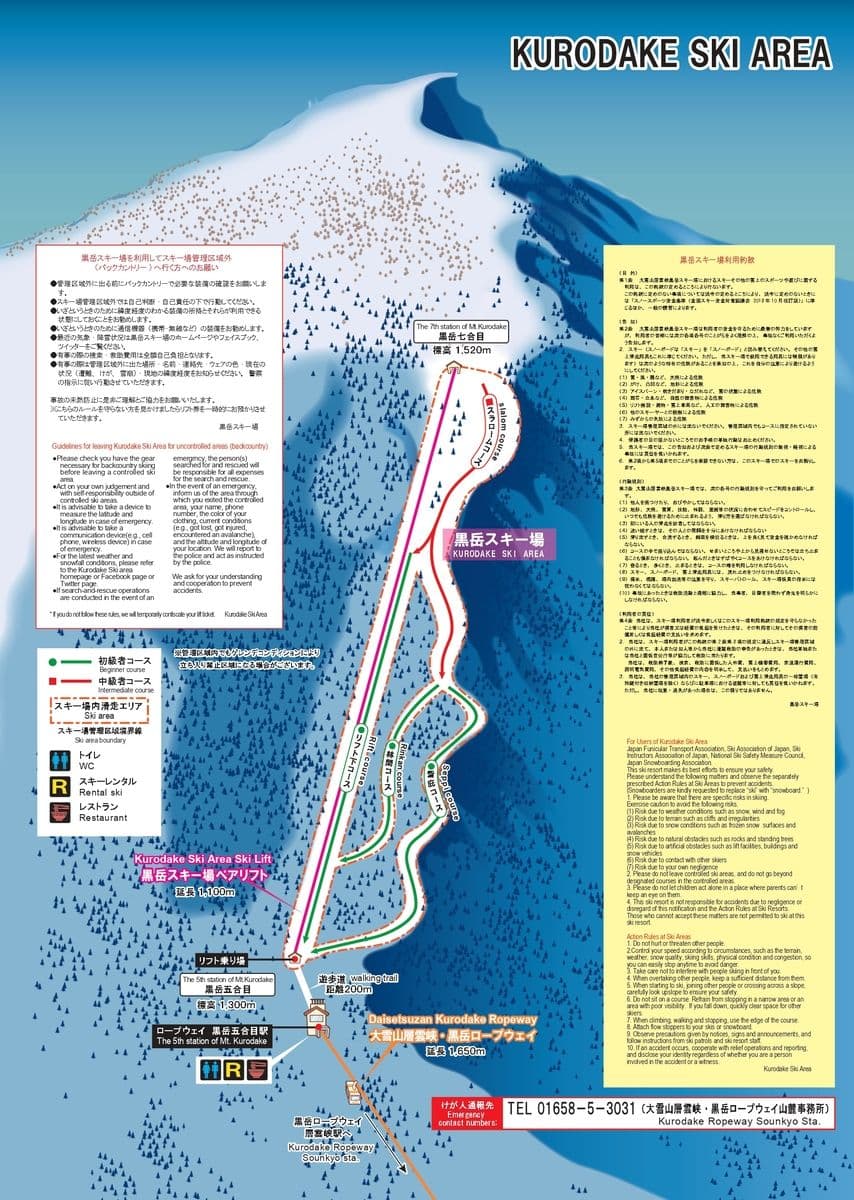Kurodake
Steep, wild, and absolutely worth the gamble

黒岳
Where the ropeway drops you into the good stuff
Kurodake sits above Sounkyo Onsen, a dramatic slot of basalt cliffs in the heart of Daisetsuzan. You ride an aerial tram (ropeway) from town to the 5th station (~1,300 m), then a pair chair to the 7th (~1,520 m). From there it’s either mellow groomers on the official course or the kind of steep, technical terrain Hokkaido isn’t “supposed” to have — all looming above a classic hot-spring village.
The lift-served area on paper is small and the on-piste vertical is modest. But the feel is big — serious alpine weather, real avalanche hazard, and bowls and tree shots that ski far larger than the trail map suggests. It’s the antithesis of resort sprawl: one ropeway, one chair, and the rest is yours to scope.
Crowds? Barely. Kurodake’s fickle weather and austere setup keep the powder hordes at bay. On storm cycles the ropeway may go on wind hold or close for maintenance, but when it spins you’re into fresh tracks well past mid-morning. Bring a flexible plan and a sense of humor — you’ll earn every turn, and you’ll remember them.
The vibe in Sounkyo is quiet: big onsen hotels, a handful of simple eateries, and a winter ice-festival scene. English is spoken at larger hotels and the visitor center; signage is otherwise limited — it feels wonderfully, stubbornly Hokkaido.
Resort Stats
- Vertical850m (1520m → 670m)
- Snowfall~15m
- Terrain 40% 30% 30%
- Tree Riding
- Lift Pass$30
- Lifts1 ropeway + 1 pair chair
- Crowds
- Out of BoundsOpen at your own risk
- Night Skiing
- Family Friendly
- Trails3
- Skiable Area~20ha
- VibeRopeway-served wild snow
Trail Map

Powder & Terrain
Kurodake skis in layers, and reading those layers is the whole game. From town (~670 m) the ropeway lifts you to the 5th Station (~1,300 m), then a pair chair to the 7th (~1,520 m). Lift-served vert is a modest 220 m, but the mountain rides much bigger thanks to steep trees under the ropeway and sub-alpine bowls above the chair. On good days you can link top-to-town off-piste lines for roughly 800–850 m of fall line — route-finding and conditions permitting.
Below the ropeway, the trees are steep, technical, and consequential. Drainages dog-leg, cliff bands guard fall lines, and visibility can shut things down fast. This is where you mine the goods after storm cycles once the ceiling lifts: sheltered snow, natural features, and that satisfying sensation of threading a line you had to earn. Patrol won’t manicure hazards here, so treat it as backcountry and keep your terrain handrails tight.
Between the 5th and 7th Stations, the chair serves a broad, low-angle bowl with 1–2 groomed tracks and off-piste glades spilling off the sides. It’s your warm-up zone and your storm-day fallback — a place to feel the wind’s fingerprints, check bonding, and rack up easy powder turns while you decide if the day will go higher or deeper into the trees. The pitch sits in the low- to mid-20s, playful for strong intermediates, restorative for tired legs.
Above the chair, skins unlock the sub-alpine. The push toward the 1,984 m summit is short but exposed, and the payoffs are clean ridgelines and bowls that funnel back toward the 7th Station. Expect wind to sculpt the surface — lee pockets ski right-side-up and creamy, windward ribs run chalky or crusted. Read the texture, watch for forming cornices and cross-loaded features, and commit only when the snowpack is giving you green lights. Full kit — beacon, shovel, probe, skins — is non-negotiable.
Capacity is low by design: one ropeway, one chair, and usually light traffic. That means powder lingers well past the 10 a.m. scramble you see at the mega-resorts. The trade-off is weather — wind holds and a mid-winter maintenance window can bench you. Local playbook: be in position for first cars when the flags relax, lap the chair edges while visibility settles, then step into the sub-alpine if the sky opens. Keep a conservative exit plan for top-to-town runs, and carry skins for short climbs if your chosen drainage dog-legs away from the ropeway.
Who's it for?
Advanced and expert riders who value steep trees, consequential terrain, and a little uncertainty in exchange for quality snow and real mountain character. If your crew is mostly intermediates seeking mileage, Kurodake is best as a one-day curiosity between Furano, Kamui, and Asahidake. If you’ve got beacon-shovel-probe, skins, and the judgment to use them, Kurodake is a must-hit — a compact gateway to big feels.
Accommodation
Sounkyo Onsen does two things beautifully: big steaming baths and easy ropeway access. The hillside grand hotels (think classic buffet dinners, multiple baths, mountain views) make weather days painless — a strategic base when you’re waiting out wind holds. Rooms are comfortable, rates are generally mid-range for Hokkaido, and weekday pricing is kinder.
For tighter budgets, look to smaller pensions/ryokan and mid-week deals — Sounkyo’s visitor flow is as much onsen sightseeing as ski traffic, so you can snag value if your dates are flexible. Expect quiet streets at night and satisfyingly simple meals: ramen, curry, izakaya hits.
The onsens are the après. Soak outside in a steaming rotenburo while the gorge goes pink at dusk, then tuck into an early sleep before chasing first car. During the ice festival, the village gets lively for a spell; otherwise, Kurodake is blissfully low-key.
Food & Après
You’re not here for a culinary safari, but you won’t go hungry. Ramen and donburi staples near the main drag, casual grill plates, and the all-you-can-handle hotel spreads if you’re staying in-house. Beer happens… but the real “bar” is a hot spring. Think recovery, not nightlife — this is a pow mission, not a pub crawl.
Getting There
Closest airport: Asahikawa (AKJ). The typical public-transit path is AKJ → JR Asahikawa → Dohoku bus up to Sounkyo. Figure roughly 2.5 hours all-in when connections behave. By car: about 1.5 hours from Asahikawa, ~2.5 hours from Sapporo, and about 4 hours from New Chitose (CTS), weather depending. Roads into the gorge can glaze — winter tires are mandatory, and after heavy storms occasional closures/chain controls aren’t unusual. Free parking sits by the ropeway base.
Japow Travel Tips
- Hours & holds: Ropeway cycles at intervals; expect wind holds and an extended mid-winter maintenance break in some seasons.
- Backcountry reality: Treat ropeway terrain like backcountry — cliffs, tight trees, and real terrain traps. Carry beacon/shovel/probe, tour with partners, and bring skins in case a line dog-legs you into a short climb.
- Snow character: Central Hokkaido cold keeps it dry; wind in the alpine is the main variable. Tree zones stash the soft stuff on stormy days.
- Language & logistics: Functional English at hotels/visitor center; less so elsewhere. Cash-friendly.
- Nearby hits: Kamui for playful trees, Furano for a bigger lift network, Asahidake for tram-served touring, Tomamu for a weather hedge.
Verdict: Lean setup, big-mountain payoff
Kurodake isn’t built for volume — it’s built for moments. When the ropeway spins and the weather window cracks open, the mix of steep trees, alpine panels, and cold, dry snow feels like you snuck into a secret chapter of Hokkaido. String it into a Powder Belt road trip, soak like a champion, and be ready to strike. When it’s on, Kurodake delivers.